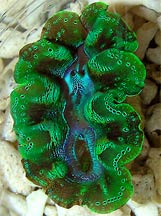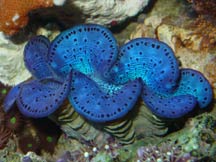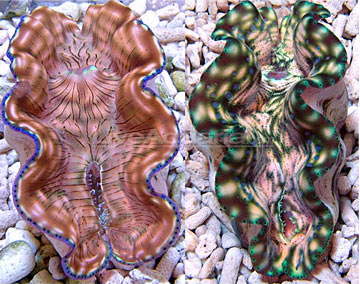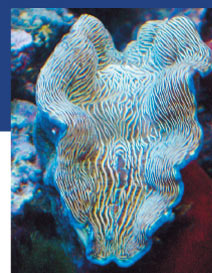Here is a good read too...
http://www.liveaquaria.com/PIC/article.cfm?aid=117
Giant Clams for Beginners: Beautiful, Hardy & Beneficial
Drs. Foster & Smith Educational Staff
If provided the proper conditions, giant clams are a great choice not only for the beginner reef aquarist, but even for the most advanced reef aquarists, offering beauty, biological benefits as well as biological diversity. Proper lighting, water movement, trace elements and placement of the giant clams will ensure the health of these fascinating invertebrates.

The clams of interest are of the genus
Tridacna. These beautiful clams include:
T. maxima,
T. crocea,
T. squamosa and
T. derasa. There is amazing variation in color and pattern within these species, some resembling living pieces of art, making
Tridacna clams highly desirable.
Benefits to your aquarium
Besides their beauty, clams provide another important benefit to a saltwater aquarium: biological filtration. Their superior filtering capabilities offer added stability and nutrient control in a closed aquarium system.
Excess nutrients lead to problems with low pH, algae, and cyanobacteria blooms - general poor water conditions that ultimately affect the health of all inhabitants within the aquarium.
Clams constantly filter nutrients such as ammonia and nitrate from the water thereby reducing the biological load and lowering the overall nitrate level in the aquarium, improving water conditions.
Environmental Requirements

Proper lighting is the most critical parameter essential to the well being of giant clams.
Tridacna clams not only filter nutrients from the water to satisfy their dietary needs, but also employ algae cells within their mantle called zooxanthellae. These algae cells require light as well as nutrients from both the clam and the water to properly photosynthesize. The clam then utilizes the energy the algae cells produced through photosynthesis to aid in its growth.
Clams therefore require moderate to high lighting conditions, ideally supplied by
power compact fluorescent fixtures or
metal halide fixtures. If using fluorescent fixtures, simply place the clam closer to the light source.
Water Movement
Tridacna clams do not like strong, direct water currents. They prefer moderate, indirect water movement. Strong, direct water movement seems to inhibit the clam's ability to adjust the amount of water passing through it, affecting their ability to properly filter the water.
Target Levels for Trace Elements
Calcium levels should be maintained between 400 to 450 ppm with a pH of 8.1 to 8.4 and an 8 to 12 DKH. Giant clams use calcium and strontium to build their shells.
Strontium levels should be maintained between 6 to 10 ppm. Slightly higher levels of strontium have proven not to be harmful to most invertebrates, but it can encourage unsightly cyanobacteria outbreaks.
Iodine levels should be maintained between 0.04 and 0.08 ppm. Iodine helps break down oxygen produced by the zooxanthellae cells and prevents damage due to excessive light exposure, helping the clam maintain their bright coloration. If the clam shows poor coloration, test the iodine level.
Trace Elements
The three main trace elements giant clams require are calcium, strontium, and iodine. These elements should be present in the aquarium at or near levels found in nature. Regular water changes and routine supplementation replenish these trace elements. However, if an aquarium is heavily stocked or if aggressive chemical filtration is used, more frequent supplementation may be necessary.
Placement
Proper placement within your aquarium is the final aspect to consider when caring for
Tridacna clams. After evaluating your lighting system and water movement within the aquarium, choose the proper location for your clam.
- Place the clam so that the mantle is facing upward towards the light to maximize exposure to light. The mantle must be in full illumination in order to provide the clam with nutrients.
- If a more powerful lighting system, like metal halides, are used on an aquarium 24 inches or less, these clams can be placed just about anywhere in the aquarium, as long as they are not blocked from the light.
- If at any time the clam moves and is lying on its side, right the clam back to the upright position. Do this immediately or the clam will slowly starve to death.
- Do not place the clam in a crevice where it may have difficulty fully opening its shell. Make sure the location is sturdy and offers enough room for the clam to grow.
- Do not place the clam in an area that has strong, direct water movement.
Aquacultured Tridacna derasa
Tridacna clams are not only some of the most beautiful additions to a reef aquarium, but because of their superior filtering capabilities, they offer added stability and nutrient control to the reef aquarium.
T. derasa clams are the best choice out of this genus. They are the hardiest of the
Tridacna clams, and will adjust to a wide variety of conditions within most aquariums - making them ideal for beginners.
CLOSE-UP: Aquacultured Tridacna derasa

Care Level: Moderate
Reef Compatible: Yes
Lighting: Moderate
Waterflow: Medium
Placement: Bottom, Middle
Water Conditions: 72-78° F, dKH 8-12, pH 8.1-8.4, sg 1.020-1.025
Color Form: Blue, Brown, Green, Yellow
Diet: Filter Feeder
Supplements: Calcium, Magnesium, Strontium, Trace Elements
Origin: Aquacultured, Cook Islands
Family: Tridacnidae
The Derasa Clam is the most widely available and hardy of the
Tridacna clams. This species is one of the largest of the "giant" clams, and grows rapidly, reaching a maximum size of approximately 20 inches. Under the proper conditions, smaller Derasa Clams can double or triple their size in less than a year. Its mantle is a mixture of orange, yellow, blue, and black and white, and usually has a wavy striped or spotted pattern, usually with vivid blues and greens.







